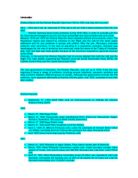The Germans responded to the occupation of the Ruhr by using passive resistance, which did not help Germany in any way, and was in fact making Germany even poorer. In August 1923 Gustav Stresemann became Chancellor of Germany. By the end of the year he put a stop to the passive resistance, and continued the payment of reparations. This took a lot of courage as many of the Germans felt as though he was giving in to France, as they did not take into consideration that their policy was bankrupting Germany. He then appointed Hjalmar Schacht, a respected banker, as currency commissioner to tackle the disastrous hyperinflation problem.
In addition to this, Stresemann then cancelled the old worthless mark, and introduced a new, temporary currency, the Rentenmark. By limiting the amount of this currency, the value of German money was stabilised, ending inflation, and in the next year a new permanent currency, the Reichsmark, was brought in. To keep the support of the army (right-wing), the government gave orders that left-wing state government in Saxony and Thuringia should be deposed. Once this was done, it was a lot easier for the government to get the army to act against the much more dangerous right-wing nationalists in Bavaria.
In the event of recovery, Stresemann then managed to persuade the Allies to agree to the Dawes Plan. This plan was produced by an American banker, Charles Dawes, in order to resolve the problems of how Germany was going to pay the reparations. It was a programme of loans from US bankers to help German economy recover and was signed in April 1924. 25 million marks were invested in Germany over the next five years, whilst cutting down the amount of reparations Germany had to pay to £50 million per annum. The great advantage was that it provided a break from the huge payment previously expected, though it fixed no date for the end of payments, which made the plan unpopular with a certain amount of German people.
With some reparations paid, the French and Belgians withdrew their troops from the Ruhr in 1925, and the government soon noticed a huge gain in there funds. Although Gustav Stresemann was only Chancellor for five months, he made a substantial difference and aid to the German economy. As well as helping Germany financially, he also helped the situation between Germany and her neighbours. As relations among Germany with France and Belgium improved, the Locarno Pact was soon initiated and the peace treaty was signed in October 1925, as a guarantee for the borders of the three counties.







